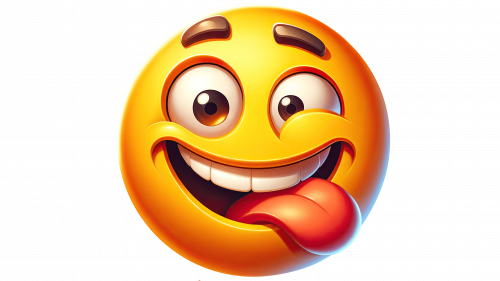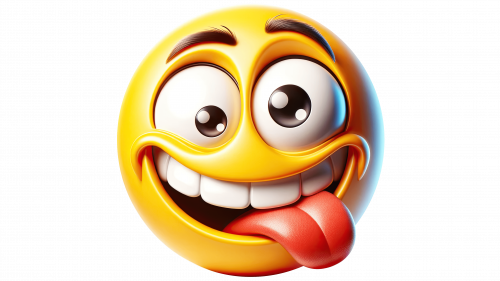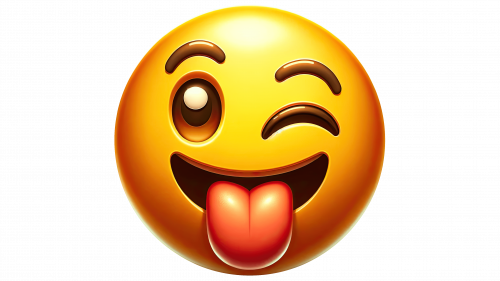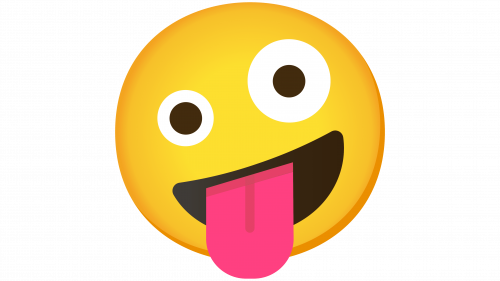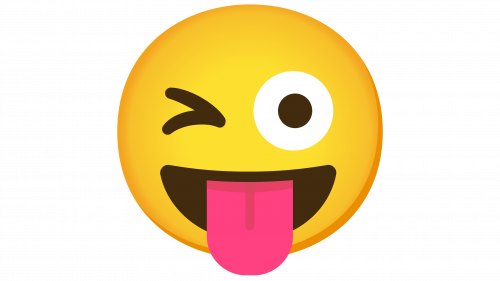Goofy Emoji expresses the utmost degree of fun and color any message in bright and humorous tones. The symbol doesn’t appear offensive but rather goofy. There are three variations of the emoji:
- 🤪 Crazy Face: The character’s eyes are looking in different directions. Its face is contorted, and the tongue is lolling to the side. This emoji was introduced in Unicode 10.0 under the number U+1F92A.
- 😜 Sticking out the tongue and Winking: The first image of this series appeared in Unicode 6.0 under the code U+1F61C. To insert the image into the text, use the combination Alt + 128539.
- 🙃 Upside Down: Another version of a silly face was added in Unicode 8.0 in 2015 under the code U+1F643. To make the upside-down face appear in the text, simply hold Alt and type 128579.
Sometimes, a clown is added to the panel of Goofy Emojis.
Meaning and use of the Goofy Emoji
The collection’s name is linked to the Disney character – Goofy, the dog. In cartoons, he always appears slightly clueless and foolish. The character is characterized by carelessness and naivety, evoking affection and a smile. The emojis created with his character, depending on the type, convey kind and cheerful messages.
The Sticking out of the tongue and Winking smiley depicts a typical childish prank – sticking out the tongue and running away. The message encourages fooling around. It teases the viewer, reminding them that there is a child inside everyone. After a hard day, serious adult conversations, or depressing thoughts, it’s time to relax and laugh.
Crazy Face conveys a somewhat different message:
- Too much to handle: So many tasks and thoughts that it’s overwhelming. “I’m exhausted,” “going crazy,” “how can I deal with all this?”
- Let’s goof around: The emoji is an invitation to have fun, to do something silly. Laugh, make faces, roll around in the grass.
- Fun until you drop: Appropriate to use when inviting someone to a wild party. Dancing, competitions, and other active activities until exhaustion – in line with the image.
Upside Down Emoji turns everything upside down. It disregards the rules, adding a note of mischief to the written word.
Sometimes, Goofy Emoji signs are sent in response to a suggestion or opinion that seems silly. “Are you out of your mind?,” “That’s nonsense,” “Idiotic joke.”
Final thoughts
The emojis in this category invite the user to relieve tension. Every day, we live in a society with behavioral norms. We need to be dressed and combed, speak politely, not shout, eat with a spoon and fork, etc. However, staying restrained and walking “on a tightrope” can be hard. Sometimes, the tension and pressure of “correct actions” can be too strong.
The emoji invites you for a moment to let go of norms and shed the constant burden of decency. It’s a useful exercise – to play crazy to not go insane in reality. Therefore, if you receive such an emoji, don’t hesitate to put aside your tasks and have fun.
One should not take seriously a message containing such a symbol. Rather, the message should be read with humor.
The 🤪 Zany Face Emoji or Crazy Face Emoji, characterized by its playful expression with a stuck-out tongue and mismatched eyes, serves as a digital embodiment of lightheartedness, mischief, and a touch of craziness. This emoji captures the spirit of fun, wackiness, and spontaneous silliness. The 🤪 emoji is primarily used to convey a sense of humor, playful goofiness, or to indicate that someone is joking or not taking themselves too seriously. It’s perfect for adding a tone of levity to messages and is often used in casual, friendly conversations to express a jovial, whimsical, or slightly eccentric mood.
The 😜 Winking Face With Tongue Emoji, featuring a playful wink and a cheeky tongue, is a dynamic symbol of humor and lightheartedness. This emoji encapsulates a spirit of jest, teasing, and a carefree attitude, often used to convey a sense of fun in digital communication. 😜 is commonly used to add a playful tone to messages, indicating that the sender is joking, teasing, or not to be taken too seriously. It’s effective in conveying sarcasm, playful mischief, or to lighten up a conversation. This emoji is a go-to choice for adding a touch of humor and playfulness, especially in casual interactions.
The 🙃 Upside-Down Face Emoji, featuring a smiley face turned on its head, is an intriguing and playful symbol in the digital communication realm. It’s characterized by a whimsical smile and eyes that gaze right side up, creating a curious blend of normalcy and inversion. The 🙃 emoji is primarily used to express irony, lighthearted sarcasm, or to add a quirky twist to messages. It’s perfect for conveying a sense of playfulness or absurdity, often in situations that are somewhat contrary to the emotion being displayed. This emoji can also be used to indicate that things are amiss or topsy-turvy, either literally or figuratively.
Text examples:
- “Decided to dye my hair neon green 🤪💇♂️”. Here, 🤪 is paired with a haircut emoji to convey a playful and daring attitude towards a bold new look.
- “I binge-watched the entire season last night 🤪📺.” This example uses the emoji to express a lighthearted admission of indulging in a TV show marathon.
- “Whoops, totally forgot to turn off the oven! 🤪🍪”. In this context, 🤪 is used to add a humorous spin to a minor forgetful mistake, keeping the tone light and funny.
- “Just pretended to forget your birthday 😜🎂 Gotcha!”. In this example, 😜 is used to reveal a playful prank, lightening the mood and adding an element of fun to the message.
- “Managed to finish all my chores… or did I? 😜🧹”. Here, the emoji adds a playful twist to an everyday statement, suggesting a mischievous or joking undertone.
- “Who says you can’t have cake for breakfast? 😜🍰”. This sentence uses 😜 to express a playful defiance of conventional norms, emphasizing a carefree and humorous attitude.
- “Forgot my umbrella on a rainy day, as usual, 🙃🌧️.” In this context, 🙃 adds a humorous, self-deprecating spin to a common forgetful moment, underscoring the irony of the situation.
- “Just my luck got a flat tire on the way to an important meeting 🙃🚗.” Here, the emoji is used to express a lighthearted take on an unfortunate event, highlighting the absurdity of bad timing.
- “Accidentally sent an ‘I love you’ text to my boss 🙃📱”. This example showcases the emoji’s ability to convey awkwardness and embarrassment in a humorous, self-aware manner.
